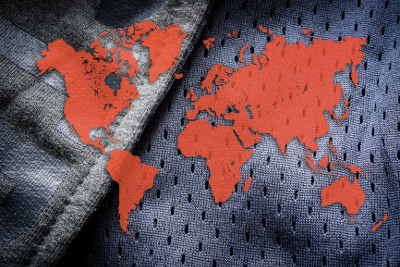 Where’s the best country for manufacturing garments? As a garment importer, you have many options to choose from, each with compelling pros and cons to weight in your decision.
Where’s the best country for manufacturing garments? As a garment importer, you have many options to choose from, each with compelling pros and cons to weight in your decision.
China, Bangladesh, Vietnam and India are four of the largest garment exporters in the world. Of 348 garment importers surveyed on InTouch’s website since October 2016, 61 percent said they source garments from at least one of these countries. China is still the most popular choice for garment importers at 21 percent. But Bangladesh and India tie for second place at 14 percent, while Vietnam comes in right behind at 12 percent.
While all four countries have a well-developed garment industry, each has a unique business climate that may be more or less suitable for your manufacturing needs. Low cost labor is certainly a key factor in choosing a supplier for manufacturing garments. But don’t discount other concerns that can affect your quality and deliverability, like labor productivity and infrastructure development.
By proactively managing product quality, it’s possible for garment importers to achieve their desired quality standard when sourcing in Asia (related: How Betabrand Limits Quality Defects to Delight Their Garment Buyers [Case Study]). Let’s look at these four countries and break down some of the key metrics you should consider when deciding where to manufacture your garments.
Trends in garment industry growth
Almost every consumer in the Western world probably owns a piece of clothing with “Made in China” sewn on the label. For many years, China has retained its position as the largest clothing exporter in the world, but this could change in years to come. While China’s garment industry has still recorded an average of 4 percent growth since 2010, it recorded negative 7 percent growth in both 2015 and 2016.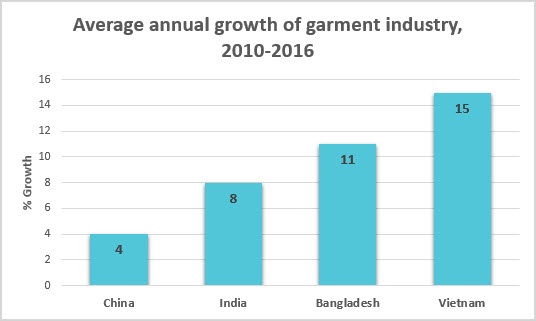
China’s gradual move away from labor-intensive garment manufacturing is typical of industrialized countries as wages and standards of living rise and population growth slows. China’s government not only acknowledges China’s inevitable shift in manufacturing, but is actively promoting it through the “Made in China 2025” initiative. This government initiative focuses on improving China’s competitiveness in high-tech manufacturing by fostering advancement and innovation in sectors such as robotics, automobiles and medical devices.
What might trends in garment manufacturing growth mean for importers?
China is still a major player in garment manufacturing. But garment exports will likely account for a smaller portion of China’s total GDP in the years ahead. This will present opportunities for importers of products that require more sophisticated manufacturing. But as we’ll see, China’s continued wage growth will force more and more garment importers to move production to less developed countries where costs are lower.
Labor costs: Bangladesh’s advantage
It’s no secret that the garment business, or “rag trade” as it’s sometimes called, typically chases the next cheapest pair of hands. Due to the labor-intensive nature of garment manufacturing, the industry is typically concentrated in locations with relatively low labor costs.
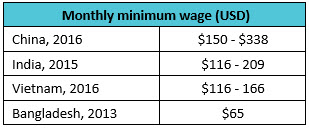 Garment production has been growing in low-cost alternatives to China like India, Vietnam and Bangladesh, as well as Cambodia and Pakistan, for the last decade. Bangladesh provides the lowest wages out of the major garment producing countries, where the monthly minimum wage for garment workers is 5,300 taka, or about 65 USD. India, China and Vietnam generally have much higher wages but lack a national minimum wage due to regional differences in economic development.
Garment production has been growing in low-cost alternatives to China like India, Vietnam and Bangladesh, as well as Cambodia and Pakistan, for the last decade. Bangladesh provides the lowest wages out of the major garment producing countries, where the monthly minimum wage for garment workers is 5,300 taka, or about 65 USD. India, China and Vietnam generally have much higher wages but lack a national minimum wage due to regional differences in economic development.
These minimum wages reflect the official, mandated rates of the regulated economy set by national and local governments. But many manufacturers may illegally operate at lower rates, particularly in India where an estimated 80 percent of workers are employed in the unregulated, informal economy. For these workers, wages might be much lower and based on piece production.
Rising labor costs in China
Garment importers’ preference for lower wages is certainly eroding China’s competitiveness in the sector. Rising wages in recent years have priced China’s East Coast provinces, the traditional heartland of Chinese garment production, out of the market for many high-volume, basic garments.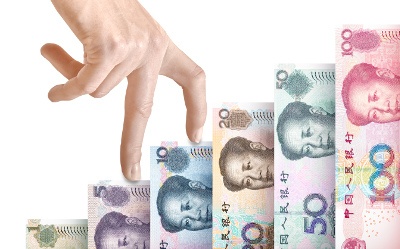
In China, Shanghai has the highest monthly minimum wage at 2,300 RMB (338 USD), with similar rates in other tier-1 cities like Beijing and Shenzhen. Minimum wages in county-level cities in smaller provinces can be as low as 1,000 RMB (150 USD). But even these low rates can’t compete with the other countries’ when solely comparing labor costs.
To stem the loss of manufacturing to other countries, the Chinese government is providing incentives for manufacturers to move production to cheaper provinces in Central and Western China. For example, the government is investing $8 billion in its far western Xinjiang Province, a major cotton-growing region, to attract textile and apparel companies. And to some garment manufacturers, it’s certainly a promising offer as tax benefits, rent and power subsidies make it a “near-guaranteed profit.”
But will China continue to foster its garment industry when faced with opportunities in the high-tech sphere? It’s a risk garment importers might want to consider.
Labor availability and productivity
Many importers consider India a major potential competitor to China for manufacturing due to its huge workforce, second in size only to China’s (related: Manufacturing in India vs. China). This large workforce makes India a particularly attractive option for manufacturing garments. But although India has significantly lower labor costs than China, this has not always proved to be enough for manufacturers to relocate to India.
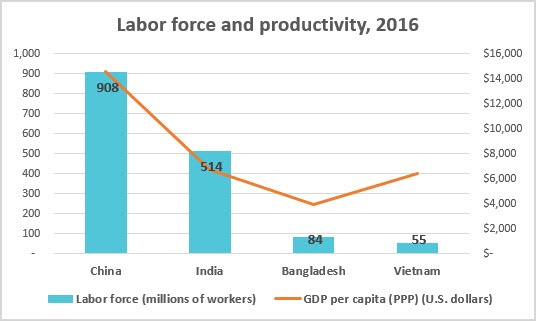 One reason for this is the productivity of workers. Per-capita GDP, adjusted for purchasing power parity (PPP), is one measurement of a country’s productivity. Typically, a higher per-capita GDP reflects a higher level of productivity, as it measures the value each individual provides to the economy. While wages in India are significantly lower in India than in China, the above measurement shows India’s productivity is also estimated to be less than half of China’s.
One reason for this is the productivity of workers. Per-capita GDP, adjusted for purchasing power parity (PPP), is one measurement of a country’s productivity. Typically, a higher per-capita GDP reflects a higher level of productivity, as it measures the value each individual provides to the economy. While wages in India are significantly lower in India than in China, the above measurement shows India’s productivity is also estimated to be less than half of China’s.
Therefore, the savings in labor costs in lower-cost alternatives doesn’t always work out to a net benefit to garment importers. The lower rate of productivity is also a factor in longer lead times, as it takes the factory longer to complete production of a complete order.
Is skilled labor necessary for manufacturing garments?
Manufacturing garments is typically a low-skilled job, so garment importers might not be particularly concerned about whether a workforce is skilled. However, skilled labor in managerial positions increases the efficiency and productivity of a factory, which can shorten lead times. The World Economic Forum (WEF) Human Capital Index measures the “knowledge and skills embodied in individuals that enable them to create economic value” through education metrics. By this measurement, Vietnam’s human capital actually eclipses China’s, while India lags behind even Bangladesh.
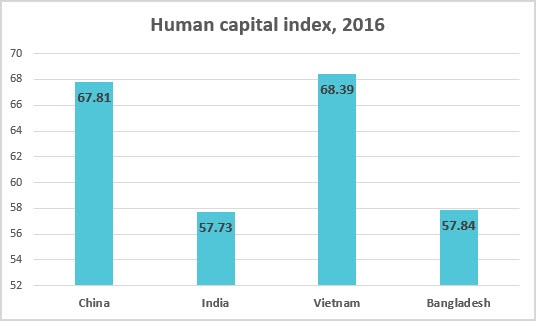 Bangladesh, in particular, faces a shortage of skilled labor in the readymade garments (RMG) industry. Of Bangladesh’s total exports, 79 percent are concentrated in five basic products—trousers, t-shirts, sweaters, shirts and jackets. Without enough skilled labor, Bangladesh struggles to diversify production and manufacture more high-end garment and textile products.
Bangladesh, in particular, faces a shortage of skilled labor in the readymade garments (RMG) industry. Of Bangladesh’s total exports, 79 percent are concentrated in five basic products—trousers, t-shirts, sweaters, shirts and jackets. Without enough skilled labor, Bangladesh struggles to diversify production and manufacture more high-end garment and textile products.
In contrast, some of China’s advanced garment factories have found a market in diversification by producing lower volumes of higher quality and more technical garments. Technical garments, also known as “techwear”, include items constructed with special fabric and techniques that allow for breathability, movement, water-resistance and comfort. Manufacturers can sell these garments at a higher margin, offsetting higher labor costs.
Trade-related infrastructure for garment producers
While garment production has started moving away from its traditional bases in China, it’s not happening overnight. A large, skilled labor force is one factor in China’s competitiveness. But China also leads in a number of other influential areas related to infrastructure (related: 3 Reasons China Remains Competitive for Importers), including:
- Burden of customs procedure – ranked on a scale of 1-7, with 7 being the most efficient.
- Timeliness of shipments – ranked on a scale of 1-5, with 5 being most timely.
- Quality of overall infrastructure – ranking on a scale of 1-7, with 7 being highest quality.
 The above metrics all point to better infrastructure development in China over the other three countries. Increased transportation times to port, slower processing times for customs and frequent power shortages can mean production halts and longer lead times for your garments.
The above metrics all point to better infrastructure development in China over the other three countries. Increased transportation times to port, slower processing times for customs and frequent power shortages can mean production halts and longer lead times for your garments.
It also might take longer to conduct an inspection or audit at a factory in a country with a less developed transportation system, as it could take the inspector longer to reach the factory. Many of China’s manufacturing areas have widespread high-speed rail networks, subway systems and bus routes. But public transportation systems are much less developed in countries like Vietnam, India, Pakistan and Bangladesh.
How poor infrastructure can end up damaging your brand’s reputation
With one of the lowest minimum wages in Asia, Bangladesh is an obvious choice for garment importers looking for lower production costs. But lower wages are a reflection of Bangladesh’s lower economic development compared with that of India, Vietnam or China.
Poor economic development can interfere with your supply chain in a number of unforeseen ways. As evidenced by the 2013 Rana Plaza collapse and lower-profile textile factory fires, manufacturing garments in less developed countries doesn’t come without significant risk to your brand’s reputation (related: Social Compliance for Garment Factories: How You Can Avoid Disasters).  Figures compiled in 2013 found that there was more than one factory fire per week in Bangladesh.
Figures compiled in 2013 found that there was more than one factory fire per week in Bangladesh.
In the wake of the Bangladesh incidents, retailers such as Walmart, Target and JC Penney signed commitments to implement significant changes to their social compliance and fire safety requirements for factories. If you choose to manufacture in Bangladesh, you’re more likely to face pressure to closely monitor social compliance and compel any noncompliant suppliers to set Corrective Action Plans to improve factory conditions.
Manufacturing efficiency with well-developed supply chain connections
A major obstacle for garment importers in India has been the fragmented local government policies across different geographical locations within the country. Part of the “Make in India” government initiative, launched in 2014, aims to lower barriers to entry and make doing business in India easier for foreign companies. Some recent improvements include reducing the number of documents needed for customs clearance, as well as allowing for electronic submissions.
Vietnam still performs markedly better than Bangladesh and India when it comes to the ease of doing business. While Vietnam’s labor costs are not as low as Bangladesh’s, stable economic policies and focus on international trade makes it more of a peer to China.
Many Taiwanese-owned factories which were formerly established in China have been moving to Vietnam to take advantage of lower labor costs. These factories already have well-established systems and processes. So staff are able to get up and running very quickly in manufacturing garments at a high efficiency level.
However, access to quality textiles is a common problem which could increase lead times. Many factories still source quality fabrics from China to then cut and sew in Vietnam. But Vietnam’s close proximity to China makes transporting raw materials rather convenient.
How to receive quality garments no matter where you source
Most professional third-party inspection companies who serve greater Asia should be able to carry out the same quality of service, regardless of factory location (related: 5 Traits to Look for in a Third-Party Fabric Inspection Provider). But you should always consider your manufacturing country when carrying out audits and inspections.
Social compliance and quality audits
Most garment importers measure social compliance and evaluate quality management systems using the same objective standards. So the process of conducting factory audits in different countries is fundamentally the same, even if issues encountered vary by location. 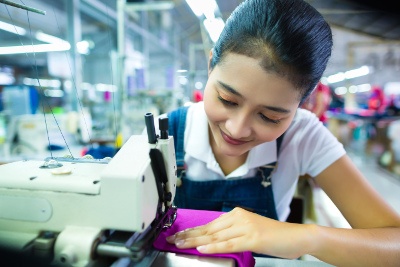 In countries such as Bangladesh and Pakistan, you’re more likely to encounter issues with social compliance and fire safety due to lax building regulations and poor government enforcement.
In countries such as Bangladesh and Pakistan, you’re more likely to encounter issues with social compliance and fire safety due to lax building regulations and poor government enforcement.
And while the factors you choose to evaluate might be the same across multiple countries, how you interpret the standards must be adjusted for the country. For example, the local wage minimums in Bangladesh and Pakistan are much lower than those in China. While a factory in China might fail a social compliance audit for wages under $100 USD, such remuneration wouldn’t be a violation for your supplier’s factory in Bangladesh.
Quality control inspection for garments
Regardless of where your suppliers are located, quality control inspection before shipping is still one of the only ways to manage product quality in garments. Whether you’re inspecting an order at a long-time partner factory in China or a new supplier in Bangladesh, your inspection criteria and reporting will likely be similar. But your product quality can vary significantly between factories, often due to a number of factors, including:
- Skill level of workers
- Quality of raw materials and accessories
- Equipment or machinery used in production
Like many importers, you may choose to adjust your tolerance for quality issues to match the price point of your product. For example, it often makes sense to set a lower quality standard for a lower-end t-shirt from one supplier than for a higher-end lady’s blouse purchased from another supplier. In turn, the latter product probably sells to different customers at a higher retail price.
Conclusion
Avoid the temptation to choose a manufacturing destination based on cost alone. Manufacturing in one country with lower labor costs can actually end up costing you more due to other factors, including:
- Worker productivity and skill level
- Factory sophistication and efficiency
- Local infrastructure
- Social compliance violation
- And more
Ultimately, every garment importer faces different constraints and priorities when manufacturing garments in Asia. But verifying a factory’s manufacturing capabilities and managing product quality with audits and inspections benefits all importers. And your customers will benefit too when they receive higher quality products from suppliers they can trust.
What other factors do you weigh in considering where to manufacture garments? Share your experience in the comments section below!







